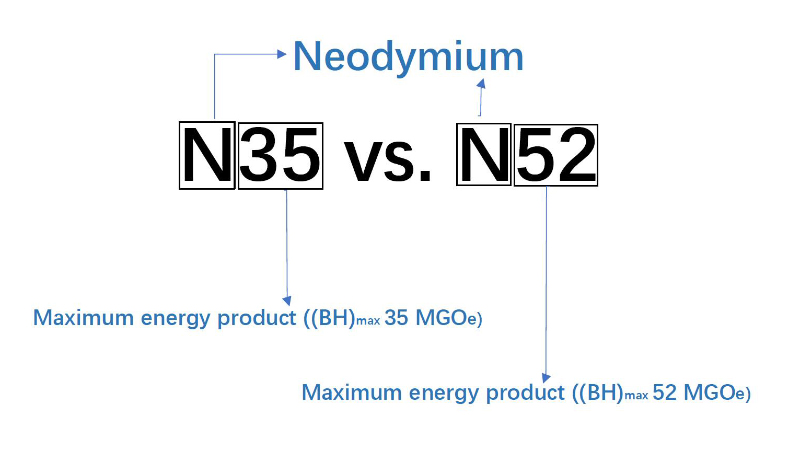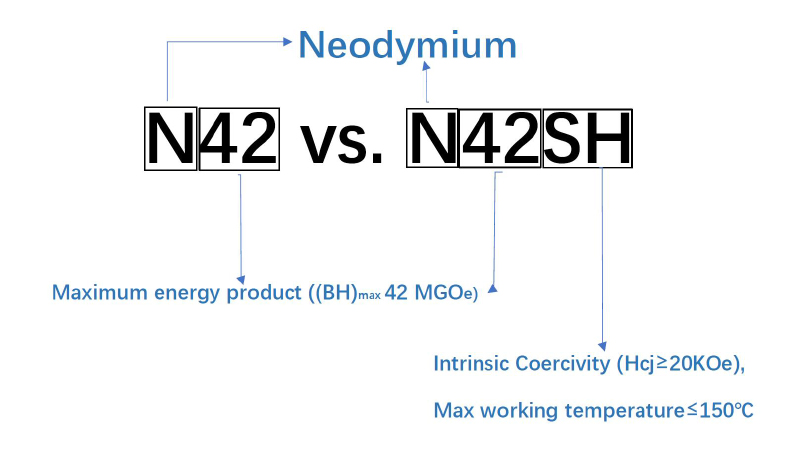Sintered NdFeB, also known as neodymium-iron-boron, is a rare earth magnet. The different grades of sintered NdFeB refer to the strength of the magnetic field they produce.
The higher the grade, the stronger the magnetic field. Some common grades of sintered NdFeB include N35, N40, N42, N45, N48, N50, and N52, with N52 being the strongest. These grades are determined by the maximum energy product of the magnet material, measured in mega Gauss-oersteds (MGOe).
The “N” followed by a number and letter in the context of sintered NdFeB magnets indicates the grade of the magnet.
The “N” stands for “neodymium,” one element that makes up the magnet material. The number indicates the maximum energy product of the magnet material, measured in mega Gauss-oersteds (MGOe). The letter indicates the temperature coefficient of the magnet material.
N35 vs. N52
The main difference between N35 and N52 magnets is the strength of their magnetic field, which is determined by the maximum energy product, or (BH)max, of the magnet material.
N35 magnets have a (BH)max of 35 MGOe, while N52 magnets have a (BH)max of 52 MGOe. This means N52 magnets can produce a stronger magnetic field than N35 magnets.
As a result, a motor or device using N52 magnets will be more powerful and/or can be smaller and lighter than one using N35 magnets.

N42 vs. N42SH
The main difference between N42 and N42SH magnets is their coercivity, or the ability of the magnet material to resist demagnetization. N42 magnets have a coercivity of 12 kOe, while N42SH magnets have a coercivity of 20 kOe. This means that N42SH magnets are more resistant to demagnetization than N42 magnets.
In addition, the maximum working temperature of N42 magnets is 80ºC, while for N42SH magnets, it is 150ºC. N42SH magnets can operate at higher temperatures without losing their magnetic properties. magnet material to resist demagnetization.

To gain a more comprehensive knowledge of the magnetic properties chart, it is necessary to be well-versed in certain fundamental concepts.
Remanence
Remanence, also known as residual magnetism or residual flux density, is a measure of the magnetic field strength that remains in a magnetic material after the magnetizing field has been removed. It is commonly represented by the symbol Br and is typically measured in units of tesla (T) or gauss (G).
The remanence of a magnetic material is an important property that determines its usefulness in various applications. Materials with higher remanence are generally more suitable for applications that require strong magnetic fields, such as motors, generators, and sensors. On the other hand, materials with lower remanence are better suited for applications that require a weaker magnetic field, such as filters and transformers.
Coercivity
Coercivity, also known as coercive force or magnetic coercivity, is a measure of a magnetic material’s ability to resist demagnetization. It is commonly represented by the symbol Hc or Hci and is typically measured in units of amperes per meter (A/m) or oersteds (Oe).
The coercivity of a magnetic material is an important property that determines its usefulness in various applications. Materials with high coercivity are more resistant to demagnetization and are, therefore, suitable for applications where the magnet may be exposed to high levels of stress or heat. On the other hand, materials with low coercivity are more susceptible to demagnetization and may lose their magnetic properties under certain conditions.
Maximum energy product (BHmax)
The maximum energy product, also known as the maximum magnetic energy product or the maximum BH product, is a measure of the magnetic field strength and density that can be achieved in a magnetic material. It is commonly represented by the symbol (BH)max and is typically measured in units of mega gauss-oersteds (MGOe).
The maximum energy product of a magnetic material is an important property that determines its usefulness in various applications. In general, materials with a high maximum energy product can produce stronger and more intense magnetic fields, making them suitable for applications that require high magnetic field strength. On the other hand, materials with a low maximum energy product cannot produce as strong of a magnetic field and are better suited for applications that require a weaker magnetic field.
Curie temperature
The Curie temperature, also known as the Curie point, is the temperature at which a magnetic material transitions from ferromagnetic to paramagnetic. It is commonly represented by the symbol TC and is typically measured in units of degrees Celsius (°C) or kelvins (K).
The Curie temperature of a magnetic material is an important property that determines its usefulness in various applications. In general, materials with a high Curie temperature can retain their ferromagnetic properties at high temperatures, making them suitable for applications that may be exposed to high temperatures. On the other hand, materials with a low Curie temperature lose their ferromagnetic properties at relatively low temperatures and are not suitable for high-temperature applications.
The Remanence, Coverity, Maximum energy product, and Curie temperature of a magnetic material are typically affected by its composition and microstructure, as well as the conditions under which it is magnetized. For example, materials with a high concentration of magnetic ions and a uniform microstructure tend to have higher remanence than materials with a lower concentration of magnetic ions and a more complex microstructure. Additionally, the remanence of a magnetic material can be influenced by the strength and duration of the magnetizing field and the temperature and external magnetic fields to which it is exposed.
Conclusion
In conclusion, the different grades of sintered NdFeB refer to the strength and performance capabilities of the material. Higher grades generally have higher magnetic properties and can be used in applications that require stronger magnetic fields. However, each grade’s specific characteristics and performance depend on the manufacturing process and other factors. It is crucial to consider the intended application carefully and choose the appropriate grade of sintered NdFeB to ensure the best possible performance.
